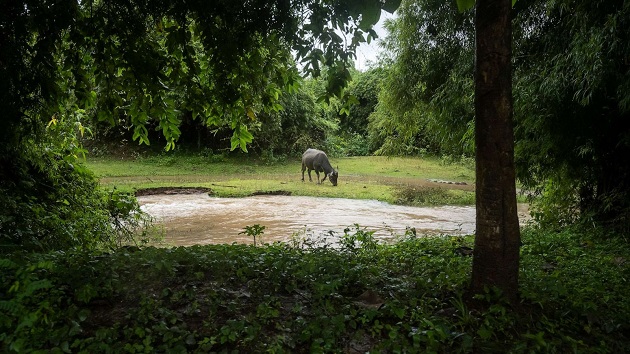
(NEW YORK) — Researchers have discovered hundreds of new animal and plant species in remote parts of the world previously inaccessible to humans, according to the World Wildlife Fund.
Among the 380 newly found species include animal vertebrates such as a color-changing lizard, a thick-thumbed bat, a poisonous snake named after a Chinese mythological goddess, an orchid that looks like a muppet and a tree frog with skin that resembles thick moss. They were all found in the greater Mekong region in Asia, according to the WWF’s New Species Discoveries report published on Sunday.
Along the Mekong River, which separates Laos and Thailand, lies miles and miles of forests housed in mountainous regions. Without roads, people have no access to the undiscovered species, which causes them to remain a mystery but also allows them to thrive, K. Yoganand, conservation biologist and wildlife ecologist and WWF-Greater Mekong regional wildlife lead, told ABC News.
“These species have been there,” Yoganand said. “It’s just, they’ve escaped, so far, the human destruction.”
Hundreds of scientists from universities, conservation organizations and research institutes around the world discovered 290 plants, 19 fishes, 24 amphibians, 46 reptiles and one mammal in Cambodia, Laos, Myanmar, Thailand and Vietnam, according to WWF.
The lush evergreen forests drenched regularly by rainfall and hidden in the mountains may contribute to the plethora of plant and animal species that live there, Yoganand said.
Nearly 4,000 vascular plants, fishes, amphibians, reptiles, birds and mammals have been discovered in the Greater Mekong region since 1997, according to the report.
One of the species scientists learned of is the Khoi’s mossy frog, a large, mossy-green colored amphibian, which helps it blend into the lichen and moss-covered stony, leafy background. The discovery was described as a “spectacular find” by the WWF.
An extremely venomous snake called the Suzhen’s krait was also found. It was named after the Bai Su Zhen, a snake goddess from a Chinese myth called the Legend of the White Snake, according to the WWF.
Discovered in the Tenasserim Mountains bordering Myanmar, researchers found Thailand’s bent-toed gecko, named after the mythical tree nymph Rukha Deva, who is said to live in trees and protect the forests, according to the WWF. The gecko aggressively opens its mouth and waves its tail side-to-side when threatened, the scientists said.
A semi-aquatic snake now known as Hebius terrakarenorum was found in the Dawna-Tenasserim Landscape between Thailand and Myanmar, according to the report. It is about 2-feet long and was identified entirely from road-kill specimens collected over a decade, as well as a few photos, researchers said.
Human encroachment is already affecting some of the newly discovered species. In Vietnam, agricultural encroachment and logging, as well as collection by communities to use as a traditional cure for abdominal pain and parasitic infection, is threatening the Thai crocodile newt, researchers said.
In Vientiane, the capital of Laos, the habitat of a new species of gecko is also being fragmented by construction projects, according to the WWF.
While many of the discoveries were the result of people surveying a never-before-explored area, some of the discoveries were known species that, after further analysis, researchers determined have several different subspecies, Yoganand said.
In Cambodia, researchers discovered the blue-crested agama, an aggressive lizard that changes color as a defensive mechanism. It was identified by studying lizards found near an Angkor era archeological site, according to the WWF. While the species has been known since the first specimen was collected in Myanmar in the 19th century, genetic analysis conducted in 2021 determined that these actually constitute many different species, Yoganand said.
Hayes’ thick-thumbed myotis, a mouse-eared bat with unusual fleshy thumbs that was named a new species after a specimen sat in a Hungarian museum for 20 years.
“These remarkable species may be new to science but they have survived and evolved in the Greater Mekong region for millions of years, reminding us humans that they were there a very long time before our species moved into this region,” Yoganand said in a statement.
While the Mekong region is a global diversity hotspot it is also experiencing a “vast array of threats,” WWF-US Asian Species Manager Nilanga Jayasinghe said in a statement.
“We must continue to invest in the protection and conservation of nature, so these magnificent species don’t disappear before we know of their existence,” Jayasinghe said.
There are 25 known global diversity hotspots around the world, including the Amazon in Central America and the eastern Himalayas, Yoganand said, adding that he expects the scientific community to keep discovering more and more species.
Immediate action and increased use of new technologies, such as bio-acoustics and genetic sequencing, are needed to help scientists discover more species in the region, Truong Nguyen, a researcher with the Institute of Ecology and Biological Resources at the Vietnam Academy of Science and Technology, said in a statement.
“To reverse the rapid biodiversity loss in the region, more concerted, science based, and urgent efforts need to be made and conservation measures need more attention from governments, NGOs and the public,” Nguyen said.
Copyright © 2023, ABC Audio. All rights reserved.








